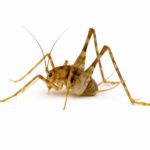 Camel Crickets often jump toward a perceived threat in an attempt to scare it away. Other types of crickets use their wings to make a chirping noise, but Camel Crickets are wingless and therefore “chirpless”. Put these two factors together and it’s no wonder so many homeowners have had a bad experience with Camel Crickets.
Camel Crickets often jump toward a perceived threat in an attempt to scare it away. Other types of crickets use their wings to make a chirping noise, but Camel Crickets are wingless and therefore “chirpless”. Put these two factors together and it’s no wonder so many homeowners have had a bad experience with Camel Crickets.
Other names for this pest include camelback crickets, spider crickets (shortened to “criders”), land shrimp (shortened to “sprickets”) and, as a result of their jump-to-scare-away behavior “#@#%&%*!!”
Camel Crickets may be found outside during the day in leaf litter, under logs, stones, in tree holes and other areas that provide shelter and moisture. Camel Crickets may also be found in damp crawlspaces or basements.
Camel Crickets are nocturnal and attracted to lights, so they may be observed wandering in search of food after dark. Their meal choice variety is rather extensive including organic matter, paper, fabrics and fur.
Because Camel Crickets require a moist environment, anything which reduces moisture will reduce Camel Cricket populations as well. These moisture reduction methods include keeping the grass short and edged, bagging clippings, removing fallen leaves and other debris as soon as possible, watering the lawn in the morning if needed and reducing mulch to not more than three inches.
If you should be experiencing a problem with Camel Crickets, or any other pest, please contact Mr. Bugg’s Pest Patrol today for an evaluation and solution.

